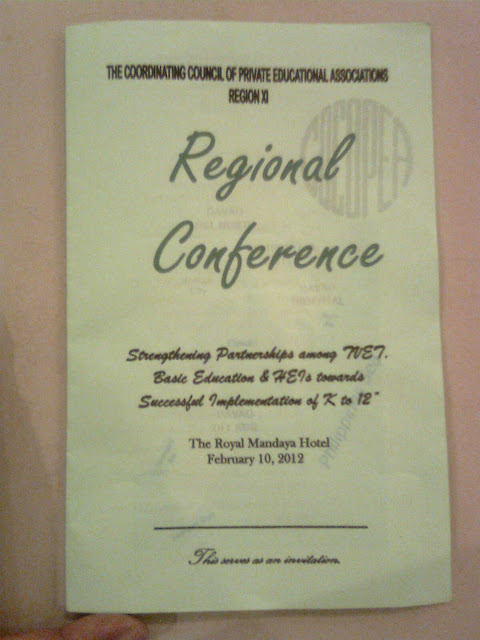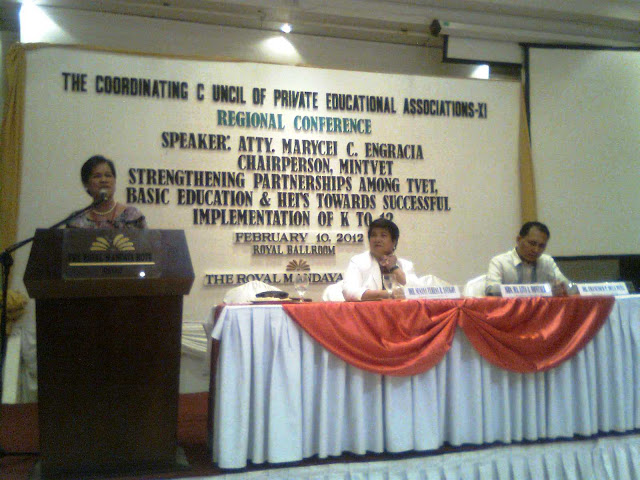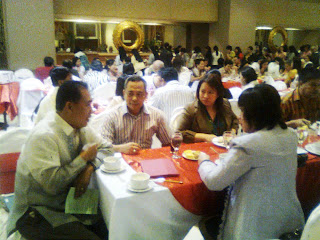Keynote Speech
Strengthening Partnerships among TVET, Basic Education and HEIs towards
Successful Implementation of K to 12
Successful Implementation of K to 12
Dr. Marycel C. Engracia
Chairperson, Mindanao TVET Association
Inroduction. The Year 2012 is not just the year of the water dragon. For us, educators and those in the business of training, it is a year of transformational and historic moment as we begin the journey of the K to 12 basic education reform. Some of us probably or hopefully are excited; a few of us may still be apprehensive and still wearing the “I-am-against-Kto12” face, but for sure, all of us, in the final analysis, will just have to accept the Kto 12 reform, with open minds and open hearts. Apparently though, your theme for this conference is already suggesting that acceptance, because here we all are, already thinking and exploring ideas on how we can strengthen linkages and partnerships among basic education, TVET and higher education Institutions. But I think that this Conference is on the right track. After the K to 12 consultations and debates last year, it is now time to settle down on our seats and simply prepare for the coming of Kto12.
I join what others say about the mood of the 21st century which is “Partner or Perish.” Other say, that Organizational success demands that you use the “Power of P” and there’s also the famous “PPP” or Public-Private Partnership. The educational organizations, private or public, is not exempted to this theoretical application. To enter the world of “partnerships” as a strategic option for organizational success, one must first embrace change and move out from the general current and conditioned mindset or at least from one’s comfort zones and then accept the challenge that it brings.
Embracing Change and Accepting the Challenge. So first, let’s embrace the change in our educational system. If you look at our educational structure, we would realize that we all went through just a series of what I would just refer to as a “condition precedent for higher levels”. So we go through and complete elementary education in order to qualify for secondary education, then we complete secondary education in order to move to college education. We graduate from college in order to work, to be an entrepreneur or to qualify for graduate education. In the law of contracts, it is similar to fulfilling a particular event before something further can occur.” Education experts and theorists would call this “articulation”, “pathways” or for a simplier understanding of the layman, “ladderization.” Whatever way it is, it really would look like a stairway to heaven, with each step or rung of the stairs or the ladder corresponding to a particular level that goes with age and maturity of the individual. A lot of theories in education and child development theories form the base to support this system and we all know that a reform in each part of the system moves some or all of the other parts.
So where’s the change and where’s the challenge? If you look at Kto 12 reform, a structural change is being implemented in terms of number of years corresponding the age and maturity level, curriculum that goes with the change of the number of years and then the rest of the surrounding circumstances will just have to follow like a domino effect such as teaching-learning processes, assessment and evaluation, qualifications of teachers, funding and financing, and others.
Change in a system sometimes is pushed by the change of the environment. The world today is just so different and it is that “very different world” that should move us to change the way we are structured to do things. For us in the education sector, there are 3 things, among so many others, that should prompt us to move towards and adapt whatever change: (1) the changing workplace environment, (2) the economy (local and global) and (3) technology. For every change and reform that is happening there are three challenges for us: we simply have to be responsive, stay relevant, and stay resilient to the changing needs of economy and society (Law Song Seng, 2005).
Given this change and reform in Kto12 now, and in keeping atuned with being responsive, relevant and resilient, there is a need for private schools and institutions to also review their defining roles, positions, and significance to society, in general.
Building Partnerships. Building and sustaining partnerships is just one among the many strategic options that schools, training institutions or Colleges can choose from as a result of the change and the challenge. Whether that partnership is between and among the 3 levels of education or whether that partnership is with Institutions other than the school or College.. that would largely depend on the areas and the goals of the partnership fro K to 12 success. There are certain key concepts of partnership, however that are universal in application, which I would like to mention as a brief background.
Partnership is both a strategic alliance and a strategic relationship. There are normally 4 properties or ingredients that make up a partnership: (1) trust, (2) equality (3) obligations, and (4) understanding. The overarching characteristic of a partnership relationship is that it is mutual and it is a covenant or solemnly agreed by both or all parties. As we all know in practice, partnerships can either be formal or one where the roles and agreements are written and the document is made public; or it can be informal where the roles and agreements are made verbally and private. Partnerships are generally agreed to complement roles, assignments, and advance mutual interests. So when conflicts of interest surface, whether found in ethical or professional practices, there can be no partnership to speak of.
So, what is there to partner with between or among us? Or what are we in partners for? To determine the areas of partnership, it is first important that we identify the different issues of K to 12 and define the imperatives from the analysis of these issues and then determine partnership opportunities. All those that lead to opportunities for partnership, of course, become possible areas for partnership agreements. An example along this line would be as follows:
Issue/s | Imperative/ Need | Partnership Opportunities |
Lack of qualified Teachers/Trainers for SHS to train NC I and NC II qualifications | The need to supply, train and qualify additional teachers/ trainers for SHS | · Cooperation Partnership on 2 areas: Capability building, Information and Resource sharing |
What should be contained in a partnership agreement? Generally speaking, these are the goals and interests of the partnership, roles and areas of responsibility of parties, authority lines, success provisions, levels of mutuality of the understanding, specifics of special challenges from which the partnership is created, if any, and other special provisions or factors that the parties may agree on.
With the new structure and system in Basic Education, there is a rich opportunity for reaching out, cooperation and sharing, and development that is before us. It is only a matter of opening our minds and hearts and welcoming the change. There are so many areas of cooperation out there that the 3 levels of education can work on such as areas of cooperation on capability building, resource sharing, agreements on software-hardware provision, providing technical assistance and support, and sharing of training in qualification levels, regional leadership and advocacy for quality assurance and continuous improvement, and so many other types of partnership cooperation.
Partners in K to 12. Partners in K to 12, I believe should not be confined between and among the 3 levels of education. Let us look at closely who can partner in specific cooperation areas. First, tripartite agreements among SHSs, TVIs, and HEIs can be developed, particularly during the Gap years. There are also opportunities for partnerships between SHSs-TVIs, TVIs-HEIs, SHSs –HEIs or partnership opportunities between same levels of education such as between 2 SHSs, HEIs or TVIs. For a more successful K to 12 partnership, it would be advisable that non-school entities be involved in the partnership such as Government Organizations namely, DepEd, Tesda, Ched, Dole, or Non-government organizations such as Chambers, or Industry groups as well as Overseas Development Agencies such as AusAid, USAid, JICA, CIDA, GTZet and others.
In all of these considerations and factors, let us not also forget that partnerships are also bound by the legal environment, and must observe ethics, norms and culture. WeT need to be aware also of prohibitions, limitations and restrictions under the circumstances that we are all operating. It is in knowing deeply the dynamics and play in partnerships that we strengthen also the relationships of the partners, in the process.
Beyond the personalities of those who enter in partnerships is to deepen the understanding of our roles and contribution in society and review once more with feelings whether our respective schools, Colleges or Institutions have contributed, someway somehow to the soci-economic impact that education brings.
Final Statements. The gap years in the K to 12 reform are crucial for all of the three levels of education, including TVET. It is not just crucial and critical, but also opportunity years for all of us so let us not look at these years as threat to our operations and existence. These gap years are also exciting years, because if we just know how to play our cards right, these are the years that we can move and explore to allied fields that might just bring good fortune for all of us. As one commercial ad would say, “may goodness ka rin.”
The TVET sector is also getting the jitters about K to 12 but I think we know that we are not treading on uncertain grounds. Our feelings are one of excitement, knowing that we are going up and moving towards a new paradig shift – from TVET to being Technical Education and Skills Development or TESD in the near future. We subscribe to this and submit to the necessity of integrating TVET in th secondary curriculum if we are to meaningfully contribute to economy. Perhaps, this is painful for small training Institutions with only NCI and II offerings, but we accept that this has to be done. We don’t like to be worried about the coming of the senior high schools because for the past 3 years now, most TVIs have not been dependent on high school students as their market. We have learned to focus on catching the drowing babies along the way, training them for skills in-demand, and making them functional in the local and global workplace. We welcome the good news that we are levelling up, utilizing more of our strengths and finding new grounds as technical education and skills development training providers. The secondary schools are also levelling up with the senior high school so that leaves the higher education sector to devise their own levelling up scheme.
What is important and the challenge for all of us right now, is to embrace the change, redefine our positions, devise strategies for success, and look forward for a “happy-all” ending and thank God for the opportunity and the gift of partnership.... Indeed, there is no other way, but UP....
And finally, because building and strengthening Partnership is an undertaking that also involves risk, let me leave to you the theme song in partnerships which we all can sing to our heart’s content.
You’ve got to know when to hold on
Know when to fold up
Know when to walk away
Know when to run
You never count your money
When you’re sitting at the table
There’ll be time enough for counting
When the deal is done....
Thank you very much.











